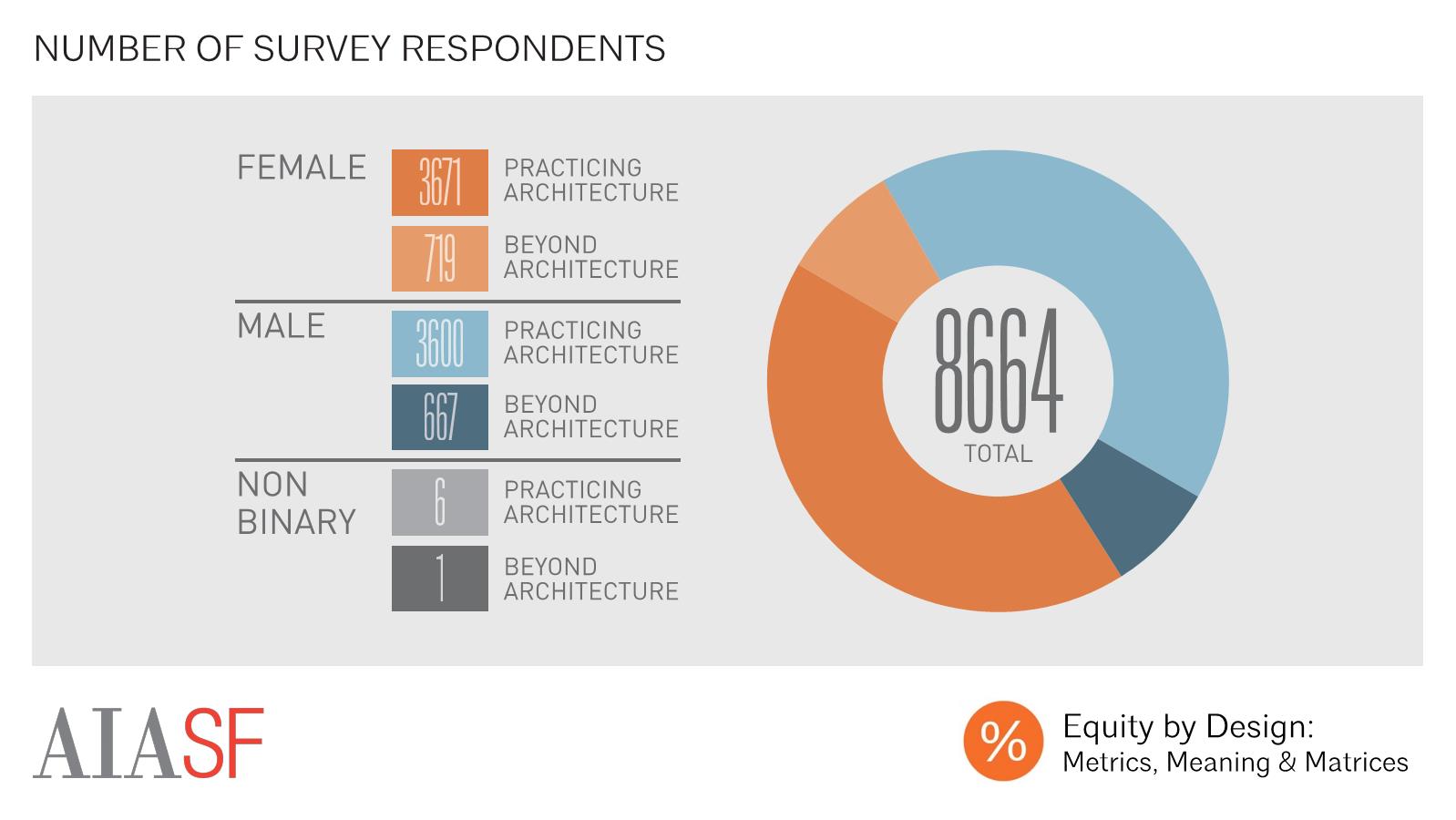Infographic Slides 2017

Gender Balance Amongst Firm Leadership
The culmination of all of these pinch points is a glass ceiling that we’ve found persists in architecture. While 8% of our female respondents, and 5% of our male respondents reported working in a firm that was mostly, or completely led by women, the majority of our respondents – male and female—reported working in a firm that was mostly or completely led by men.
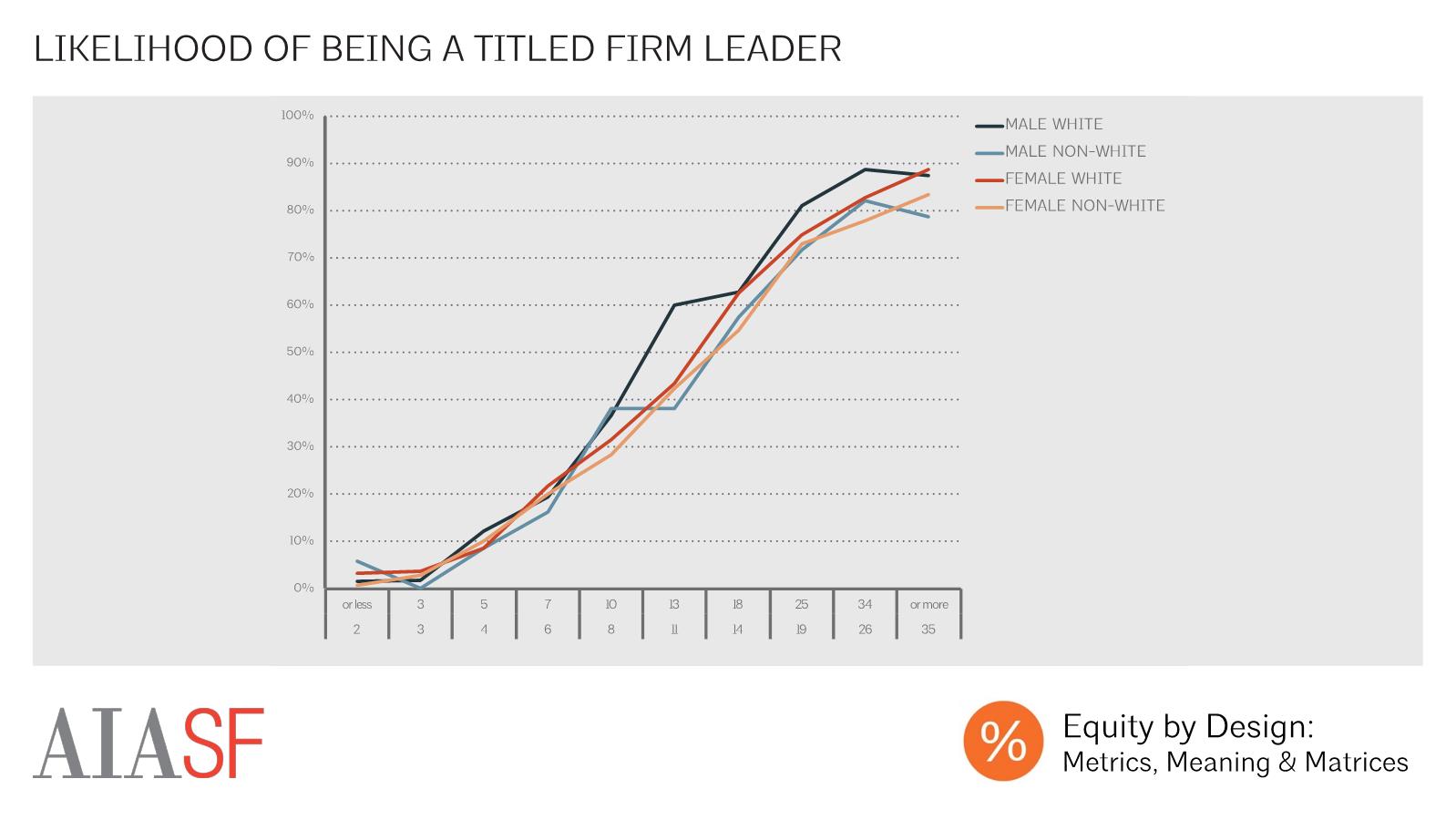
Likelihood of Being a Titled Firm Leader
Women and people of color were less likely to be firm leaders at every level of experience. This leadership gap is at its greatest amongst those with 11-13 years of experience, with 60% of men in that category, but only 38% of non-white men, 43% of white women, and 42% of non-white women, holding a titled leadership position. Amongst those with 11 or more years of experience, white men are most likely to hold firm leadership positions at each level of experience, followed by white women, and then by men and women of color.

Likelihood of Being a Principal
Women and people of color were less likely to be principals or partners in a firm at every level of experience, with men of color least likely of any group to hold this title. Significant gaps emerged amongst those with more than 10 years of experience, and generally increased as level of experience increased.
These gaps, paired with findings on likelihood of being a titled firm leader, suggests that white women, men of color, and women of color progress into mid-level titled positions at only slightly lower rates than white men, but are much less likely to make the jump into principal or partner positions.

Likelihood of Being a Principal by Firm Size
Firm size was significantly correlated with likelihood of being a principal or partner, with those working in the smallest firms most likely to be principals or partners at every level of experience.
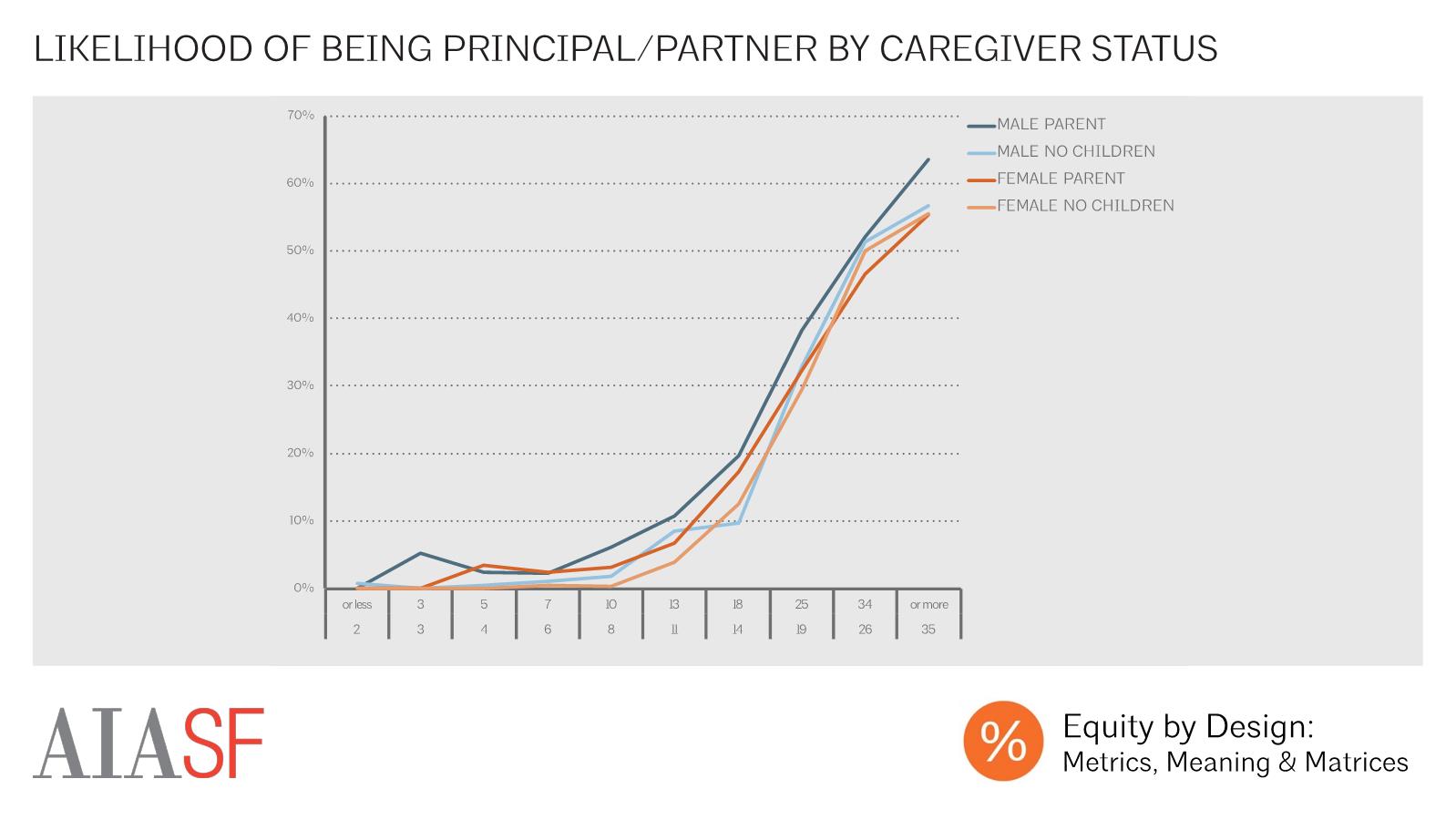
Likelihood of Being a Principal by Caregiver Status
Amongst both male and female respondents, parents were slightly more likely than those without children to be principals or partners at nearly every level of experience (women without children with 26 or more years of experience were slightly more likely than those with children to be principals or partners). For both men and women the widest “parent advantage” in terms of firm leadership exists between 14 and 18 years of experience.

Likelihood of Being Principal by Years Experience
While some of this leadership imbalance may be attributable to the pipeline issues (i.e. more men than women entered the field in the past, resulting in more men positioned for leadership in the present), this isn’t the entire story. White male respondents were more likely than non-white men and both white women and women of color to be principals or partners at nearly every level of experience. Men of color were the least likely of any group to be principals or partners in a firm.

Principals/Partners: Firm Size
In addition to being less likely to be principals or partners in firms, women and people of color who did hold these titles tended to make less money, and manage smaller firms, on average, than male principals and partners. Amongst principals and partners, female partners were slightly more likely to work in an extra-small or small firm, while male partners were more likely to work in an extra-large firm.

Principals/Partners: Equity Share by Firm Size
Not all firm leadership positions entail firm ownership. The strongest predictor of equity share amongst principals was firm size, with both male and female partners in smaller firms more likely to be equity partners, and more likely to own larger portions of their firms, than those who worked in larger firms. Within firms with fewer than 50 employees, female principals were more likely than their male counterparts to own more than half of, their firms. Meanwhile, in M, L, and XL firms, most employees owned less than 25% of their firms, and male and female partners owned similar portions of their firms.
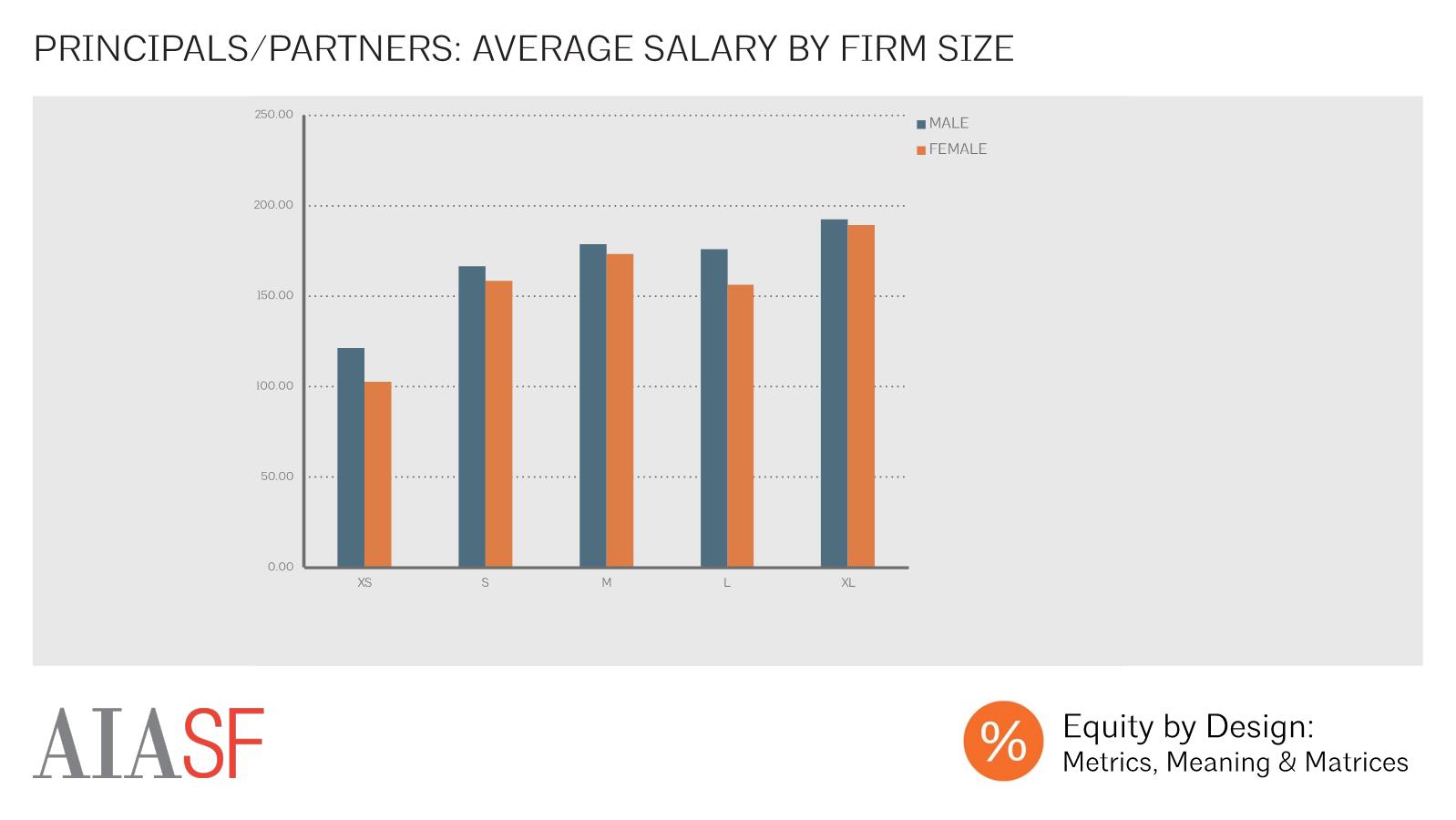
Principals/Partners: Average Salary by Firm Size
Male principals made more, on average, than female principals in every firm size. These differences were at their starkest in XS firms, even though female partners working in these firms owned more, on average, of their firms than their male counterparts.
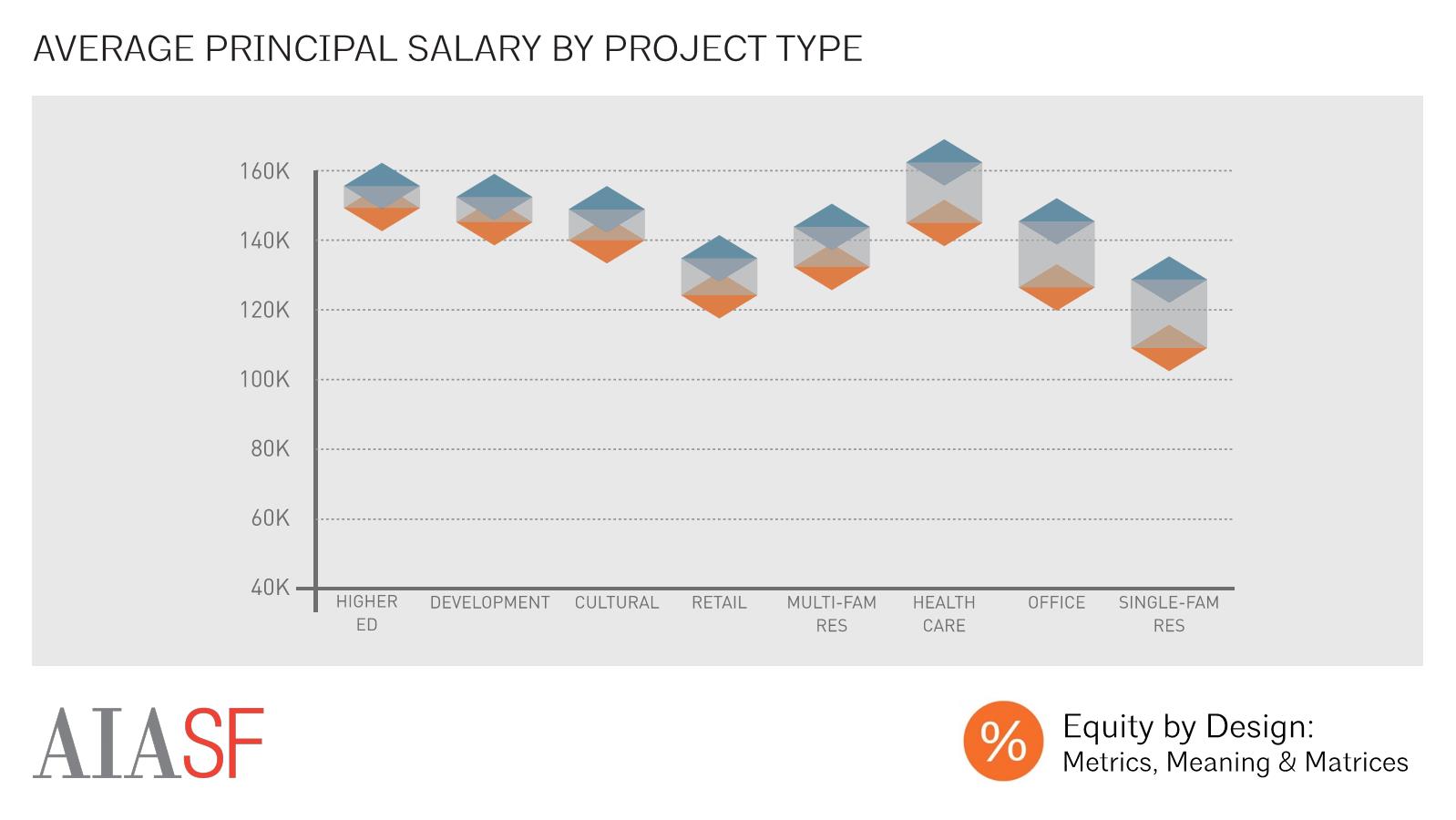
Average Principal Salary by Project Type
Amongst principals and partners, there was also a salary gap that varied by building type. The smallest gap existed between male and female partners working on higher education projects, with male partners making $6,000 a year more, on average than their female counterparts. Meanwhile, male partners working in healthcare earned $17,000 more, those designing corporate offices earned $19,000 more, and those designing single family residential projects earned $20,000 more

Metrics of Success by Leadership Title
Principals and partners -- both male and female -- had more positive career perceptions on average than those who were not principals in their firms. Non-principals were less likely to plan to stay in their current jobs, less likely to feel involved in the decision-making process, and less energized at work than those who were principals or partners. Among principals and partners, there were not significant differences between respondents’ career perceptions on the basis of race or gender, with one exception -- female partners’ perceptions of their work-life flexibility were 13% less positive than those of their male counterparts.
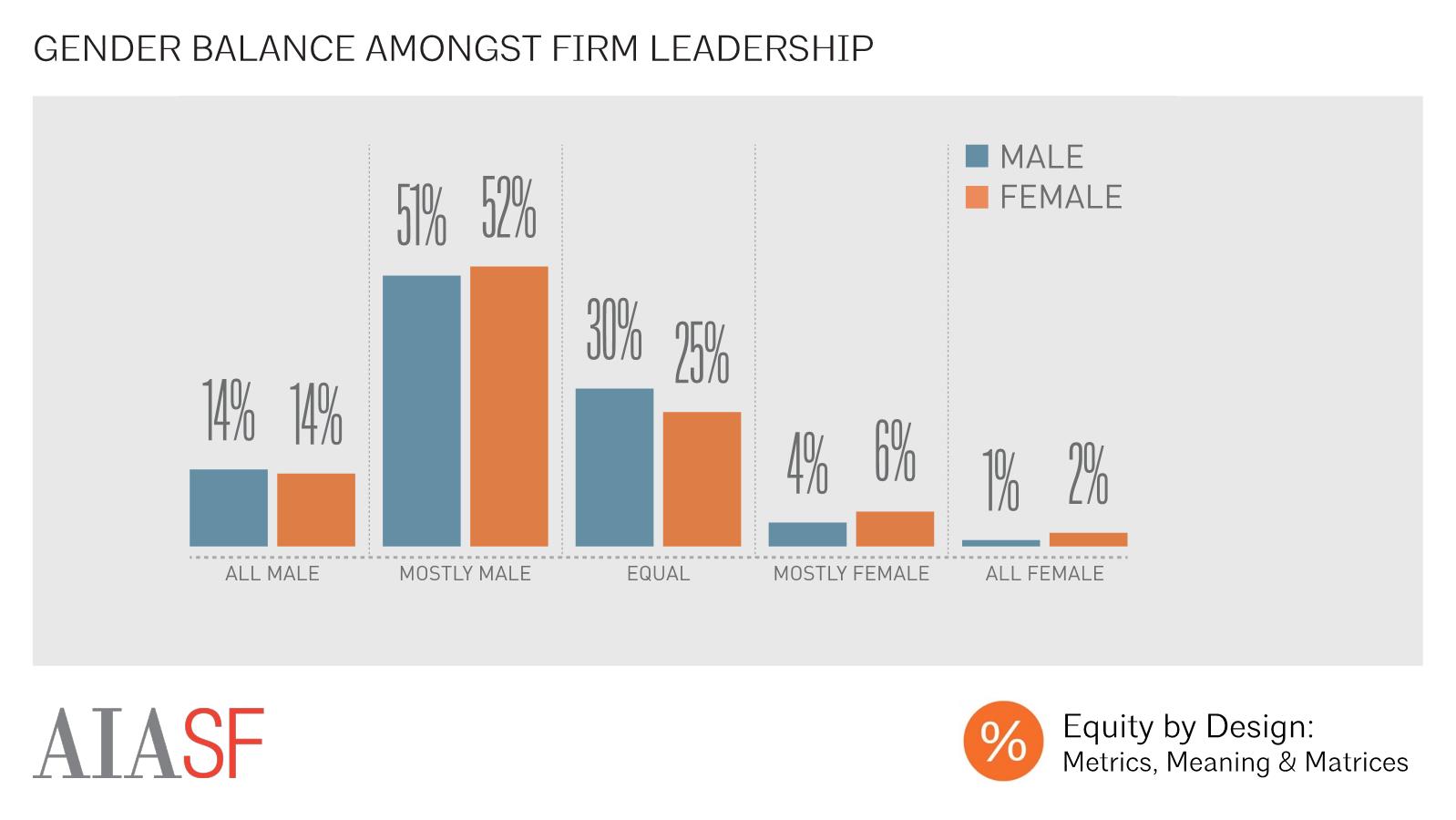
Gender Balance Amongst Firm Leadership
While 8% of our female respondents, and 5% of our male respondents, reported working in a firm that was mostly, or completely led by women, the majority of our respondents – male and female—reported working in a firm that was mostly or completely led by men.

Leadership Composition by Firm Size
Amongst male respondents, there was little variation in firm leadership composition on the basis of firm size. Amongst female respondents, however, those working in larger firms were much more likely to work in a firm that was majority male-led, with 73% of female respondents working in XL firms reporting that their firms are majority male-led, but only 52% of those working in XS firms reporting that their firms were majority male-led

Career Perceptions: All Male Led Vs. Equally Divided
Career perceptions varied significantly on the basis of firm leadership composition, with the most positive average perceptions reported amongst those working in firms with equally divided leadership. The strongest correlations were between leadership composition and career perception were in opinions of the promotion process. Compared to equally divided leadership teams, all male leadership teams’ employees had lower opinions of the promotion process (20% lower amongst women and 11% lower amongst men), lower opinions of firm culture (16% lower amongst women and 10% lower amongst men), and lower likelihood of sharing their firm’s values (13% lower amongst women and 5% lower amongst men).

Career Perceptions: Receives Guidance from Senior Firm Leader
This difference in access to leaders is significant because, compared to those who received no career guidance, those who turned to a senior leader within their firm for this type of advice were more more optimistic about their professional futures, more energized by their work, more likely to plan to stay at their current job. These correlations were stronger for female respondents with senior mentors than for male respondents.
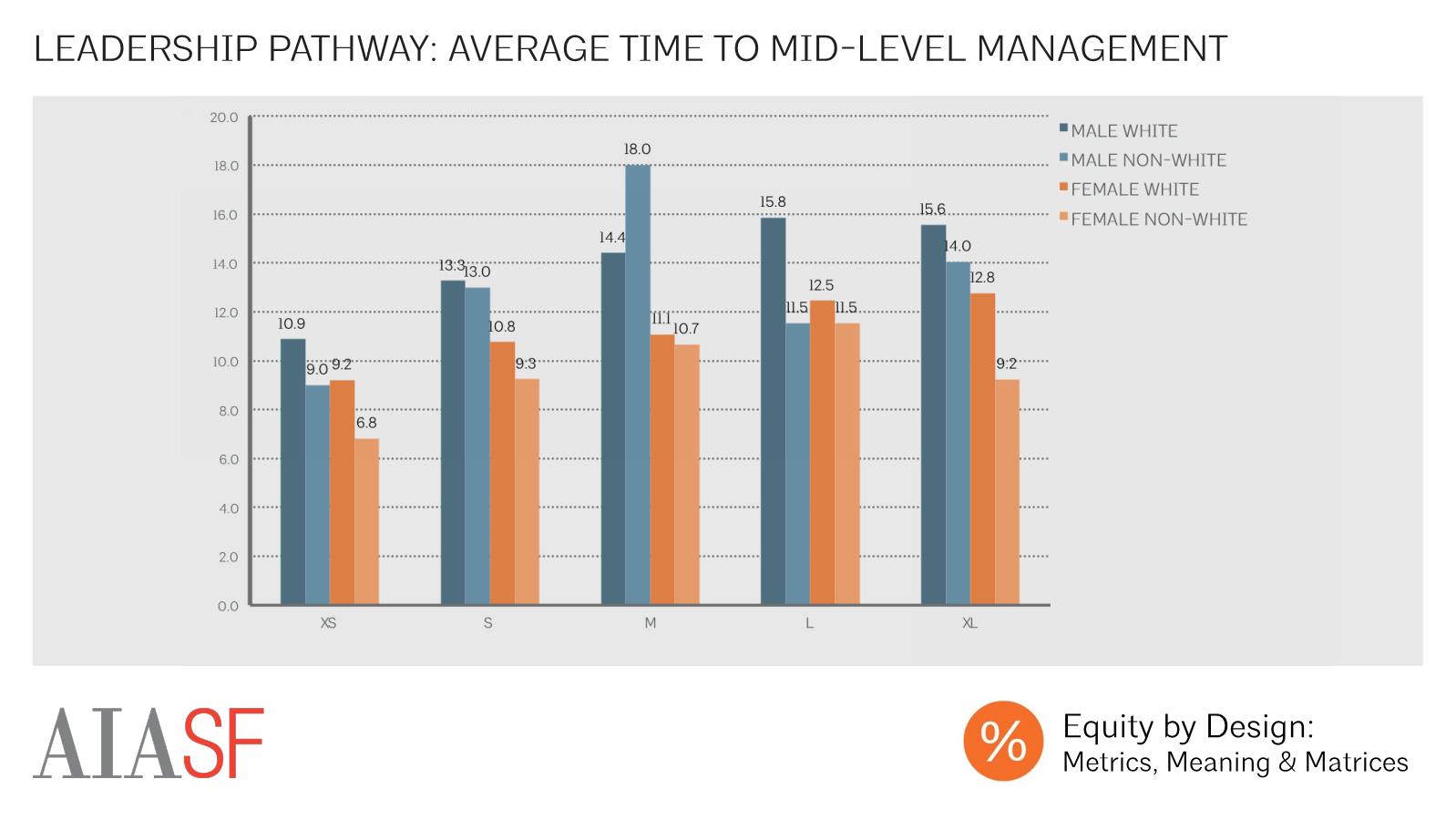
Current Leaders: Average Time to Mid-Level Management
Amongst those who had been internally promoted to a mid-level management position ( (i.e. tenure at firm exceeded amount of time as titled leader within that firm), women and people of color averaged similar or slightly lower levels of experience at time of promotion than white men. Regardless of race or gender, leaders of smaller firms had been promoted earlier in their careers, on average, than those who led larger firms. SEAONC’s SE3 project has shown that a similar phenomenon occurs within structural engineering.

Current Principals: Average Time to Principal
This trend also held true for those who had been internally promoted to a principal or partner position, with female and non-white principals and partners averaging equal or lower levels of experience at time of promotion in every firm size.

Average Time to Principal by Years Experience
These gender and race-based differences in time to leadership may be attributable to the lower average level of experience of our female and non-white respondents -- the average experience level of female principals in the sample was 10.4 years experience, while the average level of experience of male principals was 17.3 years of experience. Amongst principals and partners with comparable current levels of experience, we observed that male and female respondents reported similar levels of experience at the time of their promotion. There was insufficient data to produce meaningful analysis on this data point on the basis of race or ethnicity. These findings suggest that, while women and people of color are less likely to be promoted than their white male counterparts, those who do get promoted tend to get their position on timelines comparable to those of white male firm leaders.
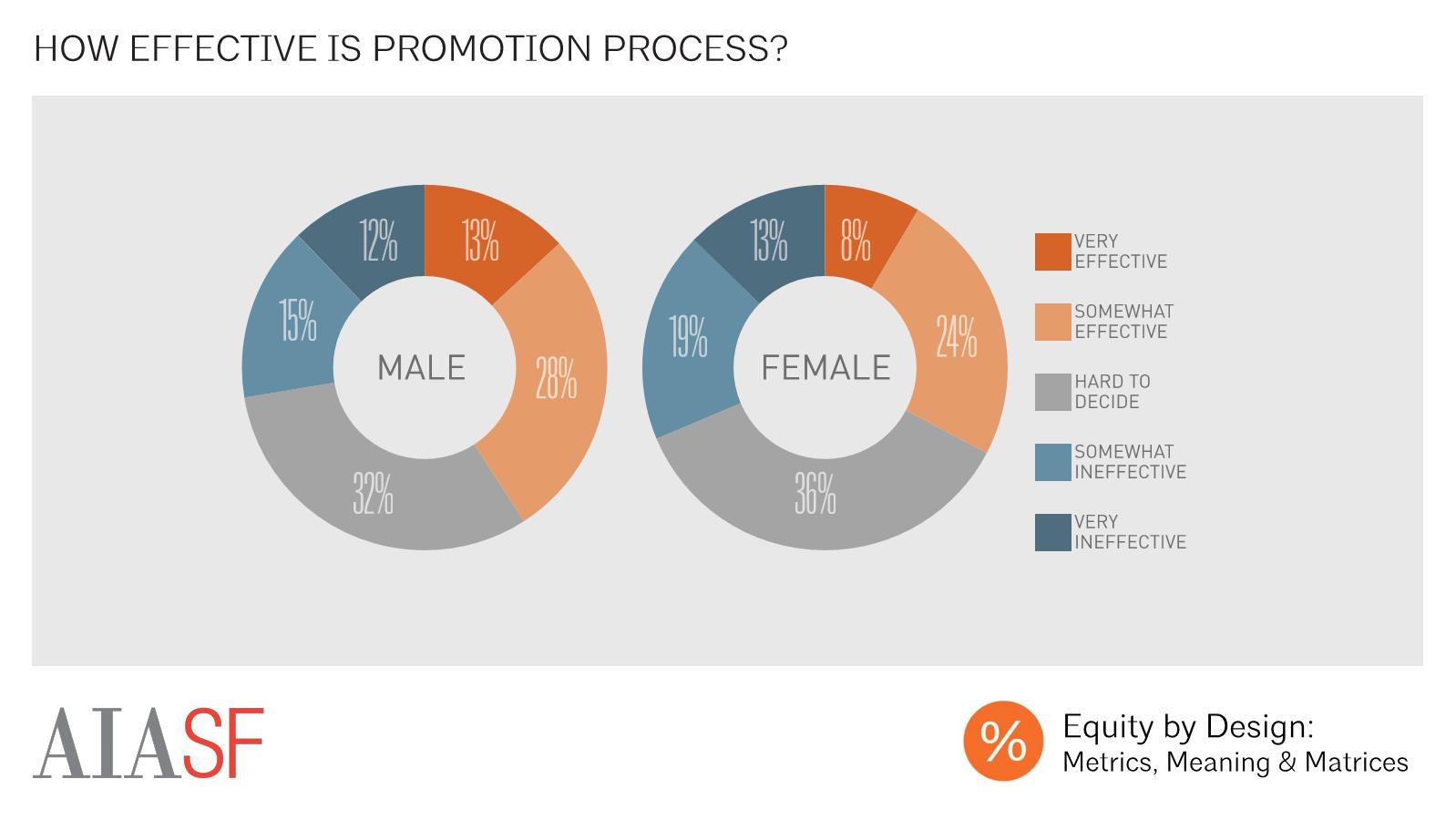
Perceived Efficacy of Promotion Process
Given female and racial and ethnic minorities’ underrepresentation in leadership within firms, and the gender differences that we saw between male and female partners’ experiences, we were interested to see our respondents’ opinions of their firms’ promotion processes. We saw that both male and female respondents had relatively low opinions of the effectiveness of these processes, with only 41% of men, and 32% of women describing this process as “very” or “somewhat effective

Efficacy of Promotion Process by Firm Size
The smaller the firm, the less likely a respondent was to find their firm’s promotion process “very” or “somewhat effective” (31% of those in XS firms vs. 41% of those in XL firms).
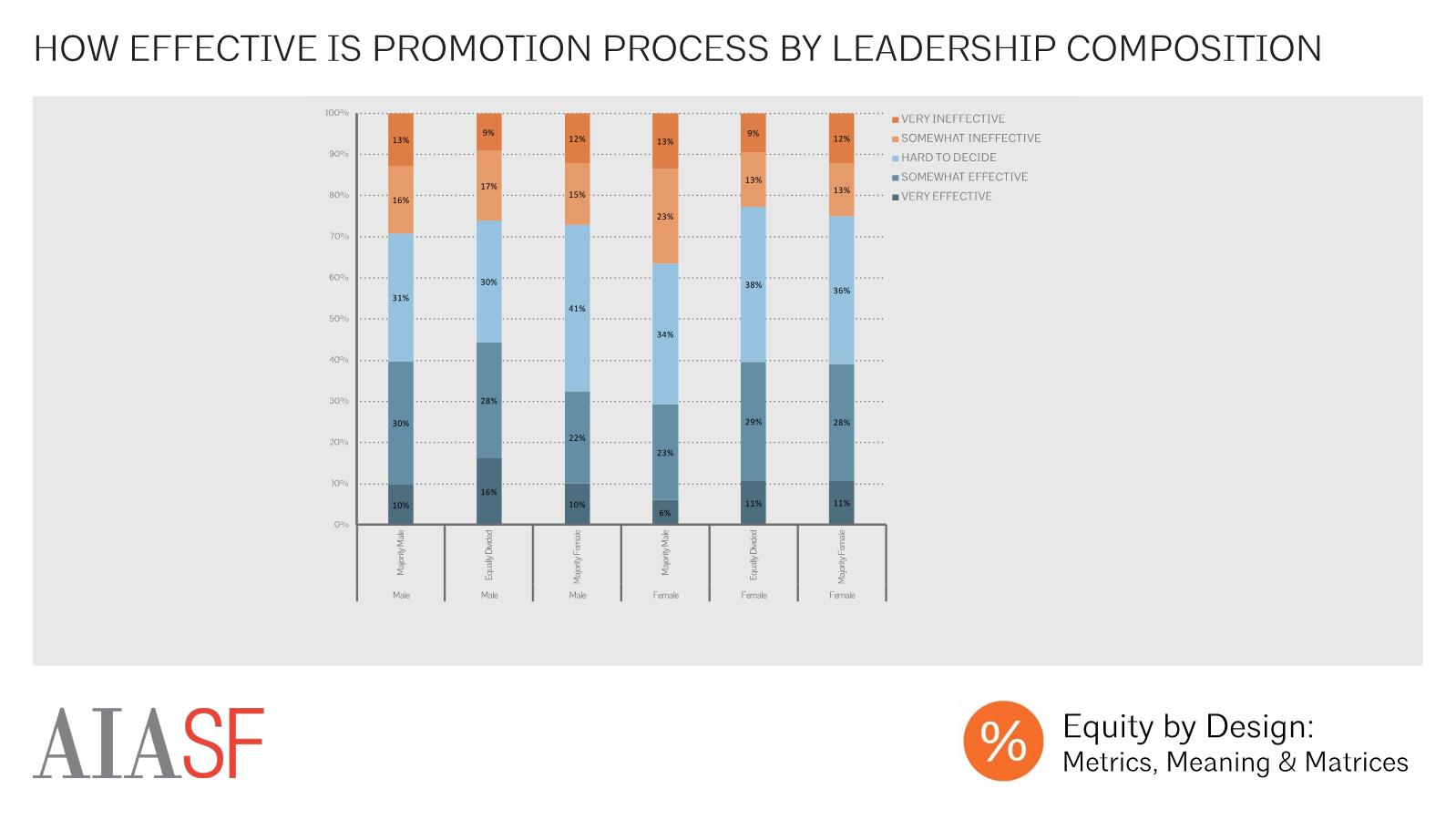
Efficacy of Promotion Process by Leadership Composition
Meanwhile, those working in firms with equally divided leadership composition -- both male and female -- were most likely to find their firm’s promotion process to be effective. Men working in majority female-led firms, and women working in majority-male led firms were least likely to believe that their firms’ promotion processes were effective.
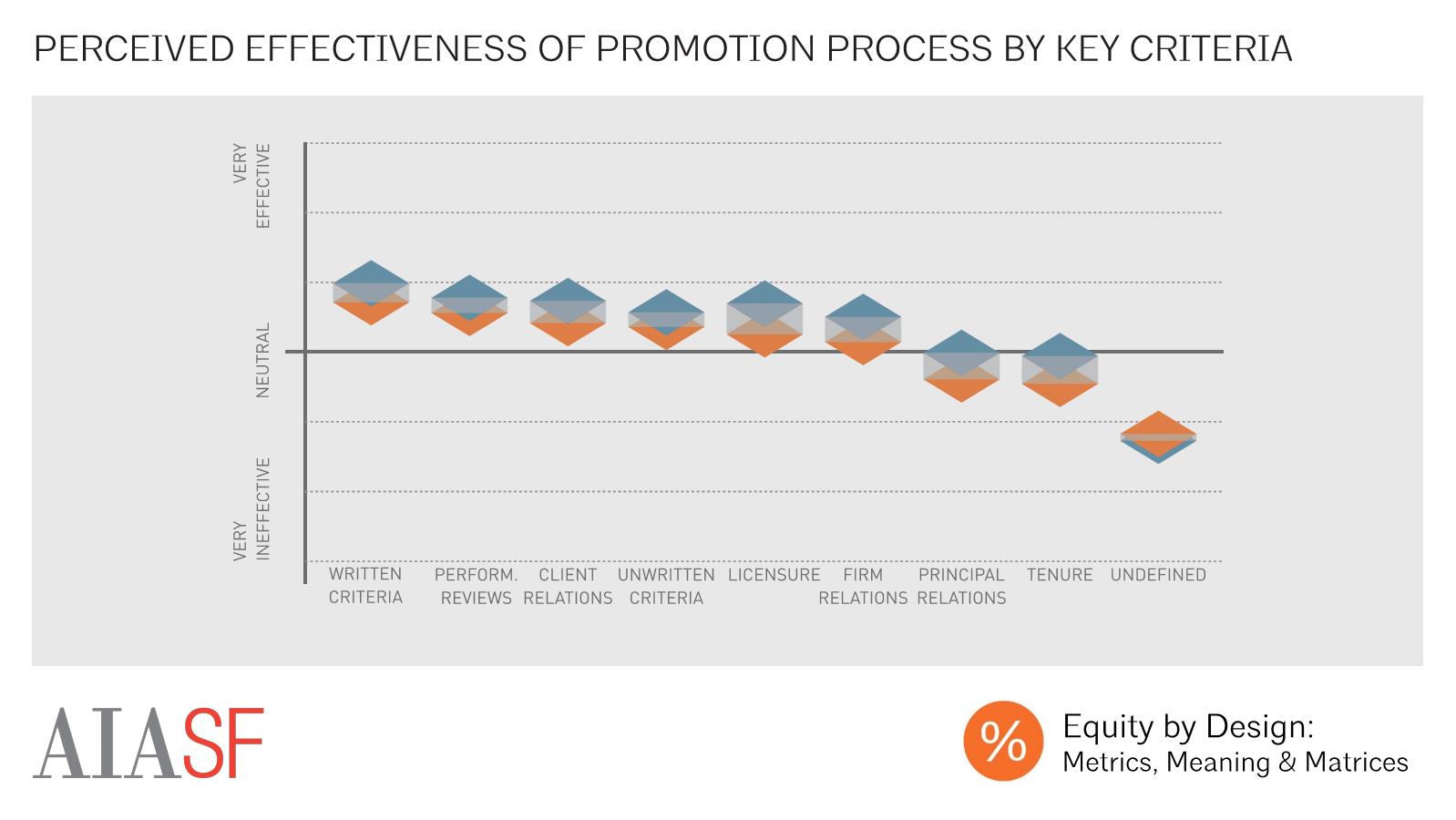
Perceived Effectiveness of Promotion Process by Key Promotion Criteria
We did see strong correlations between perceptions of the promotion process and firms’ top criteria for promotion, with those whose firms used written criteria, performance reviews, or client relationships to determine promotion more likely to have positive views of the process, and those whose firms used principal relationships, tenure, or unclear or undefined criteria less likely to view the process as effective.

Probability of Aspiring to Principal/Partner by Experience
Male and female respondents reported different career aspirations, with male respondents more likely than their female counterparts to report aspiring to be a principal or partner -- either through promotion or by starting a firm of their own -- at every point in their careers. We also noticed that those earlier in their careers were much more likely than those with more experience to report these aspirations.
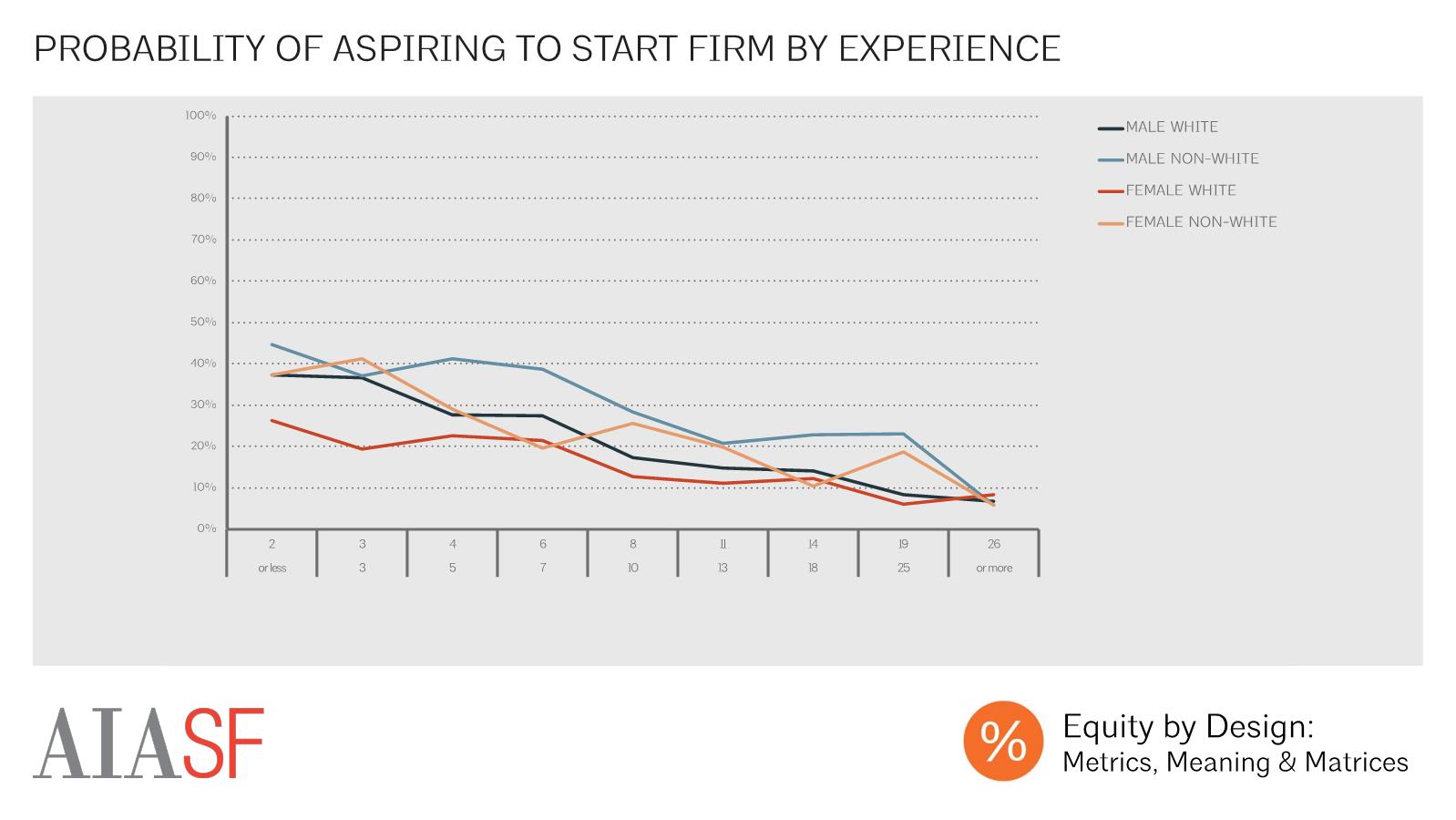
Probability of Aspiring to Start Firm by Experience
There were significant differences in how a respondent aspired to become a principal or partner on the basis of race, gender, and experience level. Those earliest in their careers, and especially men early in their careers, were most likely to aspire to start their own firm one day. At nearly every level of experience, non-white respondents of both genders were more likely than their white counterparts to aspire to start their own firm.

Probability of Aspiring to Principal/Partner via Promotion by Experience
White respondents, meanwhile, were more likely than non-white respondents to aspire to be promoted to be partner within an existing firm. White male respondents were also more likely than female and non-white male to aspire to become a principal or partner within an existing firm at every level of experience. Amongst white women, those with 8-10 years of experience were most likely to aspire to be promoted to a principal or partner position, with declining levels of aspiration amongst those in each subsequent experience bracket. Meanwhile, white male respondents with 11-25 years experience sustained high likelihoods of aspiring to be promoted to top leadership positions. While they were less likely than white respondents to aspire to be promoted to principal or partner, non-white respondents of both genders shared white male’s pattern in terms of experience level -- those in the middle of their careers were more likely than both those beginning their careers and more seasoned professionals to aspire to be promoted to a principal or partner position. This suggests that, while white female respondents’ likelihood of aspiring to be promoted to a top leadership positions peaked before they had achieved the level of experience at which these promotions tended to be occur (16 years median for female respondents), white male respondents had a high likelihood of aspiring to these promotions throughout the entire career window in which these promotions were made. Meanwhile, non-white respondents were less likely to aspire to these promotions at nearly every level of experience, instead tending to direct their aspirations towards starting their own practices.

























